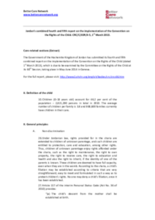The Government of the Hashemite Kingdom of Jordan has submitted its fourth and fifth combined report on the implementation of the Convention on the Rights of the Child (dated 1st March 2013), which is due to be examined by the Committee on the Rights of the Child at its 66th Session, taking place in May-June 2014 in Geneva.
Of particular note:
28. Children born outside of wedlock are cared for by foster families under special conditions. Background checks must be conducted to verify the spouses’ social and living circumstances and level of education and check that they are healthy in mind and body and thus able to raise a child properly. The family must provide all necessary forms of care (childraising, education, health, and psychological, material and social support) and meet the conditions established by the Ministry of Social Development.
29. The next table provides figures on the number of children of unknown parentage who were living in welfare institutions (Al Hussein Social Institute) between 2007 and 2012.
|
Year |
Number of |
Number of children whose mothers’ identity is unknown |
Number of children fostered and entrusted to foster families |
|
|
2007 |
31 |
39 |
26 |
|
|
2008 |
21 |
50 |
53 |
|
|
2009 |
30 |
38 |
77 |
|
|
2010 |
26 |
62 |
45 |
|
35. The principle that the best interests of the child should be the paramount consideration is spelled out in the Children’s Rights Bill. Article 4 provides that the State must safeguard childhood and motherhood, provide for the welfare of children and create conditions conducive to providing children with a proper education from every point of view in a free, dignified and humane setting where due account is taken of their best interests. As for legislation, administrative measures and amendments to the laws to ensure that account is taken of the best interests of children, a regulation (No. 49 of 2009) was issued on the licensing and management of children’s homes. The purpose of the regulation is to establish procedures for dealing with children in homes and for ensuring that the children’s best interests are the primary concern. Article 17 of the regulation states: “The home shall carry out the following tasks:
(a) Take all steps to safeguard the health, development and well-being of children;
(b) Protect children from abuse or violence of any kind in the home, under pain of prosecution;
(c) Inform children’s relatives, the Ministry and other reference persons if children are ill or if their safety or well-being is at risk;
(d) Devise alternatives to institutional care for children based on a comprehensive plan that focuses on the best interests of the children;
(e) Review the factors behind placement of children in the home every quarter to determine whether institutional care arrangements could be replaced with care in the original family or a different family, and develop rehabilitation programmes for children’s families or foster families;
(f) Refrain from publishing, exploiting or using images of the children other than for official business and in cases of necessity, as defined by a case study panel, so as to safeguard the children’s best interests;
(g) Establish and maintain administrative and financial records at the home for inspection by the authorities and Ministry officials;
(h) Create a confidential file on each child and only allow authorized persons to consult it or discuss its contents, on pain of prosecution;
(i) Provide the Ministry with figures and information every month about the children at the home.
36. Details of the number of boys and girls who have been in care institutions are provided below.
Number of boys and girls in institutions, by year:
▪ 2005: 766 children (345 boys and 421 girls);
▪ 2006: 977 children (489 boys and 488 girls);
▪ 2007: 886 children (445 boys and 441 girls);
▪ 2008: 756 children (370 boys and 386 girls);
▪ 2009: 738 children (368 boys and 370 girls);
▪ 2010: 870 children (420 boys and 450 girls).
37. According to the Children and Institutions Department of the Family and Child Directorate at the Ministry of Social Development, there were 28 care institutions in Jordan in 2011. These included two government institutions, an institution of the Royal Court voluntary institutions in the capital and in the governorates of Zarqa, Irbid and Aqaba.
National Strategic Plan on Family Protection and the Prevention of Violence, 2005–2009.
99. The focus of the strategic vision is on supporting the family as a cohesive and close-knit unit whose members enjoy the right to psychological, mental and physical well-being by creating a social, cultural and legal environment that keeps them safe, protects them from family breakdown and shields their members from violence.
103. With regard to the banning of corporal punishment, the Civil Service regulations were amended to prevent those who abuse children, particularly young children, and thus do them harm in breach of prevailing regulations and norms from working with children. Tougher disciplinary sanctions were introduced for inflicting any form of corporal punishment or injury on a child in an educational or training institution or a welfare home or shelter.

